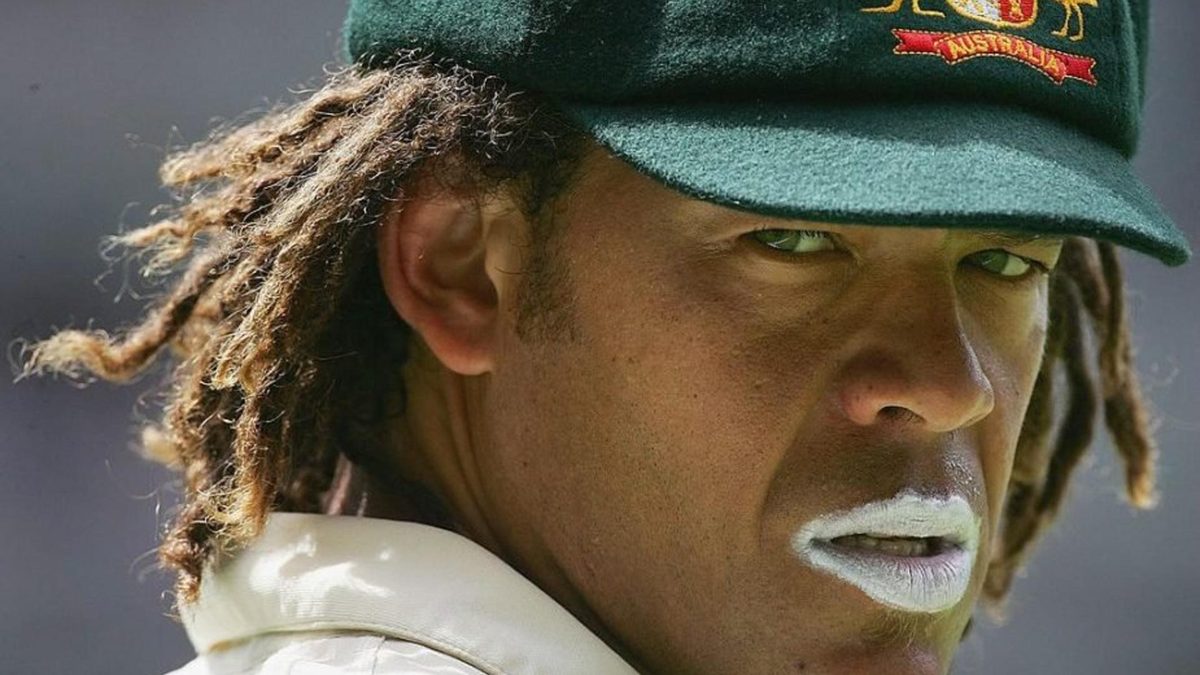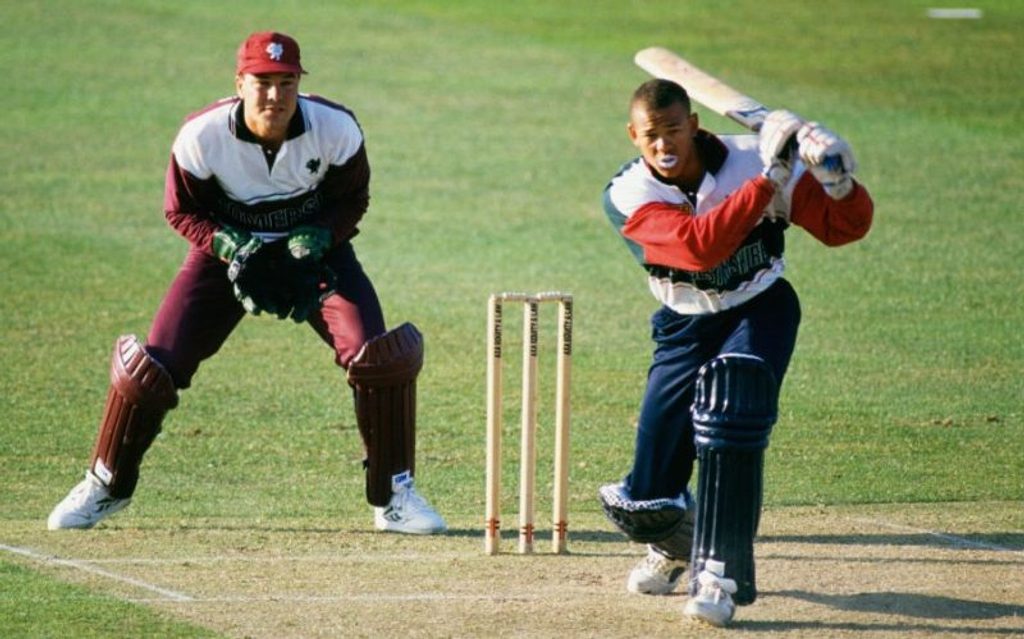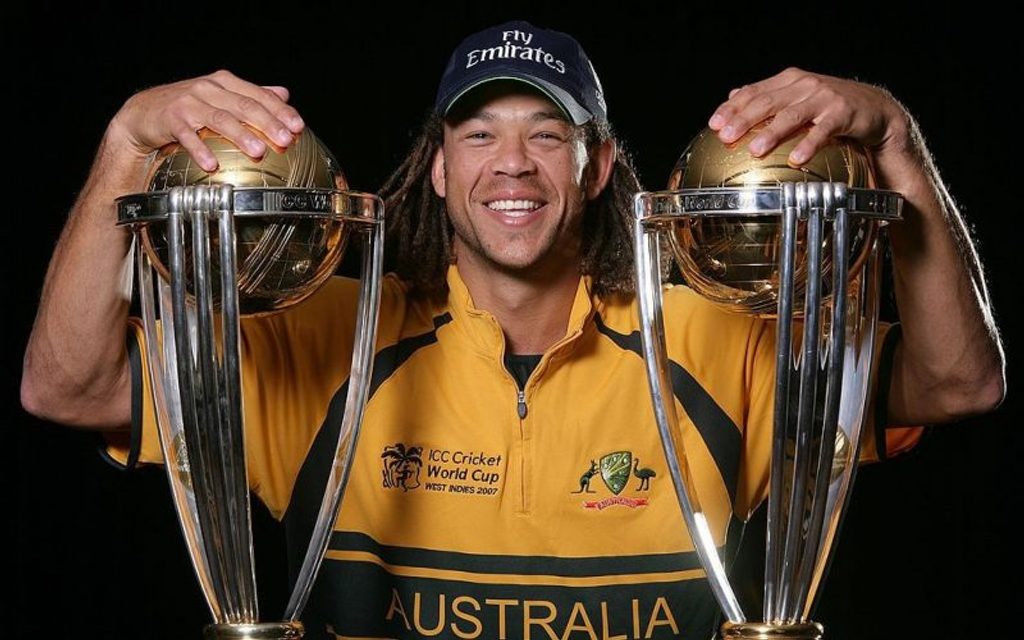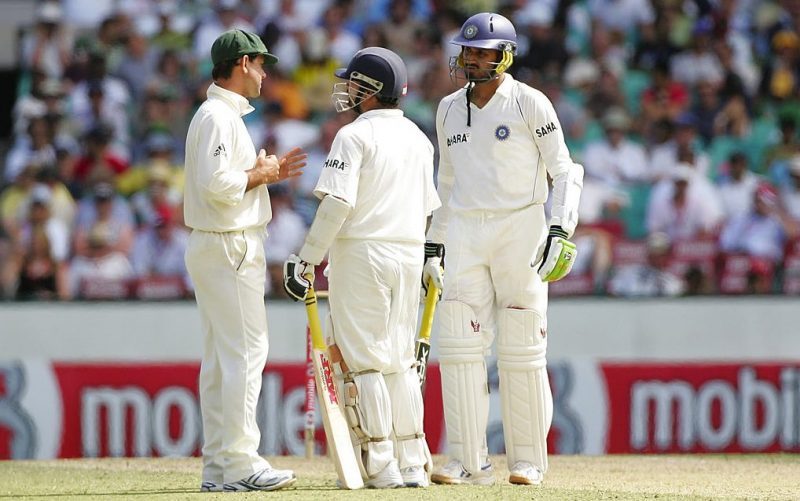
Twenty-five years on from the world-record knock which announced the arrival of Andrew Symonds, Jo Harman looks back on the career of a rare and special talent, who for a time was among the most complete all-round cricketers in the world before disappearing almost as quickly as he arrived.
“I can still see his face at pre-season,” says Jack Russell, recalling the arrival of a 19-year-old Andrew Symonds at Gloucester in the spring of 1995. “He was hungry, really hungry. That season I had us in a few weeks early to work on our fitness and he was outdoing everyone. His batting was on a different level and his fielding was way above everyone else.
“His professionalism and commitment was second to none. I know he’s had problems since but with us he was like a breath of fresh air. He was dragging everybody forward and we all got a buzz off him. We loved his attitude and were so excited with his talent.”
A few months later came Symonds’ outlandish breakout knock, the Birmingham-born Aussie peppering the postage stamp of a ground at Pen-y-Pound, Abergavenny with 16 sixes in an innings – a first-class record which stood for 20 years. The boundaries may have been small but those present at Gloucestershire’s County Championship match against Glamorgan agreed that the majority of those sixes would have gone the distance at most grounds in the world.
“I was lucky enough to be at Abergavenny to see the 16th six of Andrew Symonds’ innings sail over the outfield, a hawthorn bush and a patch of bindweed and onto a nearby tennis court,” wrote Matthew Engel in the 1996 Wisden Almanack.
Gloucester had stumbled to 79-4 when Symonds came to the wicket, and then quickly fell to 79-5, but the youngster produced the kind of counter-punch which would become his trademark. He finished day two on 197 and the following morning went through to a maiden double-century, eventually finishing unbeaten on 254 from 206 balls.
 Andrew Symonds batting for Gloucestershire in a Sunday League game at Taunton, 1995
Andrew Symonds batting for Gloucestershire in a Sunday League game at Taunton, 1995
In Gloucestershire’s second innings he belted 76 at better than a run-a-ball, upping his tally of sixes for the match to 20 – another first-class record. A star had been born. But the next steps were far from simple.
***
Symonds – or ‘Roy’ to his mates (he thinks in tribute to former Brisbane Bullets basketball star Leroy Loggins, although he’s not entirely sure of its origin) – had been brought to Gloucestershire’s attention after becoming Queensland’s youngest first-class centurion, slapping England’s bowlers around the Heritage Oval at Toowoomba during the 1994/95 Ashes tour. When the English hacks got wind of the fact that this hard-hitting teenager had been born in England, before moving to Australia with his adoptive parents aged 18 months, he was bombarded with questions about where his allegiances stood.
“It was daunting, no two ways about it, but I did my best and answered them as honestly as I could,” wrote Symonds in Roy: Going For Broke. “I didn’t want to play for England, I didn’t want to meet my natural mother but I did consider myself an Aussie. And that was that.”
Only it wasn’t. After Ian Healy and Queensland academy coach Dave Gilbert helped engineer Symonds’ move to Gloucestershire – playing as a non-overseas player through his UK passport – he would be subjected to those questions time and again during a spectacular but controversial first summer of county cricket.
Symonds came out of the blocks at breakneck speed, smashing 161 not out from 140 balls against Surrey at The Oval in his first Championship innings. Adam Hollioake, an on-field adversary who later became a good friend, remembers Symonds repeatedly hitting Richard Nowell, Surrey’s left-arm spinner, into the building site which would soon become the OCS Stand.
Happy birthday, Andrew Symonds 🎉
What an arm he had! pic.twitter.com/cLp8WFUDsL
— Wisden (@WisdenCricket) June 9, 2020
“We hated each other,” says Hollioake. “It started off when he was at Gloucester and then carried on to whichever county he was playing for. We were the alpha males. He was always the enforcer for whoever he was playing for and I was the enforcer for Surrey, so we just clashed. Everyone on the county circuit thought I was a bit of a bully, I used to hand out a lot of abuse. Queenslanders in general are pretty abrasive, hard guys and he wasn’t about to sit around and watch me sledge his teammates. He handed it out, I gave it back and it always escalated. It got to the point where both teams would just be waiting for it to happen. And it never disappointed. We’d end up face to face every game.”
It wasn’t until Hollioake and Symonds found themselves on the same side for Tom Moody’s testimonial match at Worcester in 2004 that their feud became a friendship. “We just realised we were basically the same person!” says Hollioake. “When I moved to Queensland he lived just round the corner and we hit it off.” Symonds, a passionate bushman, had found a new companion for his favourite pastime: wild pig hunting.
Back in the summer of ’95, Symonds immediately followed his blitz against Surrey by taking a Somerset attack including Andrew Caddick and Mushtaq Ahmed for a century at Taunton. He was suddenly the talk of the county circuit, and not all of it complimentary.
At the start of the season all England-qualified players had signed a contract which included a new clause stating that they had to make themselves available for the national team – yet Symonds had previously expressed his desire to play for Australia and, in his own words, sounded “as Aussie as a cow cocky from Cunnamulla”.
Graham Gooch, who had just retired from England duty, publicly questioned Symonds’ motives and the pair had a heated on-field exchange when Essex visited Cheltenham in July. Symonds responded by thumping his third century of the campaign – 123 not out from 111 deliveries, including 22 boundaries.
 Symonds was a part of Australia’s World Cup wins in 2003 and 2007
Symonds was a part of Australia’s World Cup wins in 2003 and 2007
“I felt a personal responsibility to take him under my wing and try and protect him from the flak that he was getting, not just from Essex and Goochie but from all quarters,” says Russell. “I remember saying to the officials at the club that we’ve got to protect him a little bit, to say, ‘Ignore all that, there’s none of that with us, we love you to bits’. And, from a selfish point of view, it would have been good to have him play for Gloucester for 10 or 20 years. We had an ulterior motive!
“I can remember chipping away at Symmo, trying to persuade him to play for England. With the amount of talent Australia had, there was no guarantee he’d play for them. They had so many great players who hardly played for them and I was saying, ‘You’ve got better options here’.”
Symonds even received a rare invite to dinner at the Russell residence. The visit included a tour of Russell’s art gallery in Chipping Sodbury, where a painting of an elephant caught his eye. “He just loved that elephant,” says Russell. “After he played that innings at Abergavenny I asked him what he wanted for all his gear – pads, bat, gloves – as memorabilia. He said, ‘Just give me the elephant’.”
Symonds’ world-record knock at Abergavenny took him to four centuries for the season and he finished his first summer of county cricket with 1,438 first-class runs at an average of 55, with an extraordinary strike rate of 95. It remains the highest strike rate ever recorded by a batsman who has passed 1,000 runs in an English summer. “He just dominated,” says Russell. “I was batting at the other end with him a few times and your life was in a bit of danger.”
https://www.youtube.com/watch?v=T1jHINjtFYg
Spectators weren’t safe either. In a match at Hove, a ferocious cut shot from Symonds struck a supporter in the head, and when she resumed her position after treatment, sporting a badly bruised cheekbone and a black eye, his bat picked her out again, this time hitting the woman square on the thigh. Symonds sent her flowers and a note by way of apology.
The controversy surrounding Symonds’ loyalties came to a head when, a week after being named the Cricket Writers’ Club Young Cricketer of the Year, the national selectors gave him a shove by picking him for the England A tour of Pakistan in the winter of 1995/96. He declined the invitation. “Playing sport for my country was what I’d always wanted to do and my country was Australia,” he later said. “I just happened to be born in England.”
Despite being tagged a mercenary by many in the English game, Symonds was keen to continue his county career until Australia came calling, and he signed a three-year deal with Gloucestershire ahead of the 1996 campaign. He again passed 1,000 runs for the season but that was the last Gloucester saw of him, his selection for Australia A in the winter of 1996/97 disqualifying him from playing county cricket as a non-overseas player.
“I thought we had a definite chance [of convincing Symonds to play for England] but obviously the Baggy Green is a big pull,” says Russell. “You can’t criticise him for his loyalties but he would have been in England’s Test team and one-day team, don’t worry about that. He had an attitude where he felt he could do anything, and that’s what the lads loved about him. Players thrive off that and he would have been perfect for England in that respect.”
“I know a lot of lesser characters would have just taken [the England call-up],” says Hollioake. “I have full respect for what he did. There was a lot more money in the English game at that stage but he backed himself to go back and get into that great Australian side. That was a very patriotic and brave decision.”
***
Symonds went on to make his ODI debut in November 1998 but it wasn’t until the 2003 World Cup that he truly emerged as an international cricketer. In 2002, after a succession of failures in Australia’s one-day side, he’d considered quitting the game altogether, telling Steve Waugh and John Buchanan, captain and coach, that he “didn’t feel comfortable in the Australian team environment”. Lost and desperate, he even contemplated a switch to rugby league, briefly training with the Brisbane Broncos after making a late night call to their coach Wayne Bennett.
He admitted feeling “like a bit of a fraud” when he received a surprise call-up to Australia’s World Cup squad. Heading into that tournament he had a batting average of 23.81 from 54 ODIs. But his career turned on one innings – a brilliant unbeaten 143 in Australia’s World Cup opener against Pakistan at The Wanderers.
https://www.youtube.com/watch?v=Sjl7d78EBRg
“I know a lot of people in Australian cricket didn’t want him to go to that World Cup but Ricky Ponting said, ‘I want him in there’,” says Hollioake. “I don’t believe anyone controls Andrew Symonds. I think he does what he wants to do and that’s why you want him in your side. You couldn’t have four Andrew Symonds’ in your team but having one is fantastic – that rogue player. And that’s what Ponting saw. He just accepted that Symmo was a bit different and he could do things that other guys couldn’t do. He let him have a bit of free rein. And Symmo repaid him.”
Symonds was one of the stars of the World Cup, taking the Player of the Match award for his unbeaten 91 in the semi-final victory over Sri Lanka and averaging 163 across the tournament as Australia defended their title. For the next five years he was one of the most consistent one-day batsmen in the world, averaging 48 from the start of the 2003 World Cup to the end of 2007, and he became increasingly useful with the ball, offering either medium-pace or off-spin. He was also among the very best fielders in the world – “like a tiger shark in the covers or at mid-wicket” said Ponting.
In 2004, playing for Kent against Middlesex, Symonds became only the second batsman to score a T20 century. Reached from just 34 balls, it remained the format’s fastest hundred for nine years. Four years later, after being picked up for £1.2m by Deccan Chargers in the first edition of the IPL, making him the most expensive overseas player at auction, he struck another electrifying century. And there were signs, too, that the foundations for a successful Test career were being laid. His 156 at the MCG in the 2006/07 Ashes, his maiden Test hundred, convinced Ponting that “this would be the springboard for a long and successful Test career”. For a time, he was one of the most complete all-round cricketers in the world.
Yet all the while, his career was pockmarked by controversy. The indiscretions generally involved booze, with Symonds admitting in 2009 that he had been clinically diagnosed as a binge drinker, although he denied being an alcoholic.
https://www.youtube.com/watch?v=vKVJAvFS3Zk
The most infamous incident came at Cardiff in 2005 when, in the midst of the breakdown of his marriage, Symonds went on an all-night bender ahead of an ODI against Bangladesh. After grabbing a quick breakfast on his return to the hotel, he tried to get his head down for some much-needed kip but was woken moments later by Michael Clarke pouring water over his head. It was time to get up. It was clear to everyone during the warm-up that Symonds was still drunk. He was stood down from the match, suspended for the next and fined A$8,000. Several of his teammates were furious – not helped by the fact that Australia suffered their first-ever loss to Bangladesh – and it took an intervention from Ponting to prevent him being sent home in disgrace.
Symonds returned to the side with knocks of 73 and 74 and a maiden five-wicket haul across his next three ODIs but resentment at his behaviour simmered. While Ponting remained committed to his maverick all-rounder, others were ready to cut him loose. He again considered quitting the game, in part to try to save his marriage, but eventually split with his wife Brooke later that year.
“As cricketers we’re meant to be these soulless people who dedicate our lives to our country and when things are happening off the field a lot of people don’t know the full story,” says Hollioake. “He was going through some pretty heavy stuff off the field and that contributed to him drinking too much – I think he’d probably hold up his hands and say he drunk too much for a while there. My personal opinion, he’s a good bloke. But if I was the manager of a cricket team, I’d be worried s**tless! Whatever he was doing, he was doing 100 per cent.”
***
While alcohol-related issues continued to rear their head, Ponting wrote in his autobiography, At The Close Of Play, that it was the alleged racist abuse Symonds received from Harbhajan Singh, and the fallout from that incident, which triggered the breakdown of his international career.
Symonds, who is of part Afro-Caribbean descent, had been subjected to monkey noises from the crowd during the tour of India in October 2007 and then confronted Harbhajan in the changing room after the final match of the ODI series, claiming the Indian spinner had called him a monkey while Australia were fielding. Symonds alleged that Harbhajan apologised and he considered the matter closed until India’s tour of Australia a couple of months later, when Harbhajan was again claimed to have called Symonds a monkey during the New Year Test at Sydney – a match in which Symonds scored his second and final Test hundred.
 Ponting in conversation with Tendulkar and Harbhajan after the latter’s exchange with Symonds
Ponting in conversation with Tendulkar and Harbhajan after the latter’s exchange with Symonds
Mike Procter, the match referee, held a hearing after the match, found Harbhajan guilty of a Level 3.3 charge (racial abuse) and suspended him for three matches – at which point the BCCI threatened to cancel the tour, before deciding to appeal the decision instead.
In the days that followed, Ponting was angered by a lack of support from Cricket Australia, who he saw as caving to pressure from the BCCI. Cricket Australia’s lawyers opened the second hearing by informing Justice John Hansen, a high court judge from New Zealand, that Symonds “now took the language to be offensive and seriously insulting, but did not consider it fell under the requirements of Level 3.3”. This came as a surprise to Ponting and Symonds, who, “on a matter of principle”, had told Cricket Australia they “wanted Mike Procter’s judgment to stand”.
Andrew Symonds, who last played international cricket in 2009, had a strike-rate of 169.34 in T20Is.https://t.co/mEDZmtFavE
— Wisden (@WisdenCricket) June 2, 2020
Sachin Tendulkar, who had been batting with Harbhajan at the time of the incident, gave testimony which had curiously been absent from the first hearing. It stated that “he did not hear the word ‘monkey’ or ‘big monkey’ but he did say he heard Mr Singh use a term in his native tongue ‘teri maki’ which appears to be pronounced with an ‘n’. He said this is a term that sounds like ‘monkey’ and could be misinterpreted for it”. As a result, Justice Hansen said he could not be certain that the abuse amounted to racism and in place of a three-match ban, Harbhajan was fined half his match fee.
“Maybe the Indian cricket juggernaut of the 21st century is too influential to shake,” reflected Ponting. His faith in Cricket Australia had been irrevocably damaged but he said the worst outcome of the hearing was the impact it had on Symonds. “He had never been one to seek the limelight; he loved his sport and was brilliant at it but the attention that came with it never sat well with him. In a lot of ways Symmo was gone from this moment on and it still makes me angry.”
“I felt the pressure and the weight of dragging those mates of mine into the cauldron of this cesspit,” said Symonds in 2018. “I started to drink heavily as a result of it and my life was starting to dissolve around me.”
Despite being the victim of alleged racist abuse, Symonds came away feeling like the guilty party. For many, the episode was lazily chalked up as merely ‘another Andrew Symonds controversy’ to add to the pile.
Symonds never scored another century for Australia, but his rap sheet continued to grow. In August 2008, he was dropped from an ODI series against Bangladesh after missing a team meeting while he was fishing in Darwin, and a few months later he was fined A$4,000 after calling Brendon McCullum a “lump of s**t” during a radio interview. When he was sent home from the 2009 World T20 in England for breaking team rules by drinking alcohol outside of the dressing room or team hotel, his international career was over. “This was the last of a series of instances where he broke the team rules and in total they added up to a man who didn’t really want to play for Australia anymore,” said Ponting.
The following year, having become a T20 gun for hire, Symonds expressed his relief that he was free from the cocoon of international cricket. “I wasn’t having fun anymore,” he told the Guardian in June 2010, soon after joining Surrey – back at the ground where he’d first made his mark in county cricket 15 years previously. “I wasn’t enjoying it. I felt like I was in a cage. Always under the microscope. Once I had got home from England, and everything had settled down, it was a relief.”
He spent another year on the T20 circuit before retiring from all cricket in 2011, despite the lucrative contracts on offer. For Hollioake, it was inevitable that Symonds’ career would come to a sudden conclusion.
“Andrew Symonds was never going to be a guy who hung on right to the end,” he says, “because when you’ve got players who are wearing the right stuff to training, and not going out drinking, and doing and saying the right things in team meetings, and all of a sudden he’s not producing match-winning performances every third or fourth game, then he became a bit of a liability. As soon as he wasn’t winning matches regularly, then he wasn’t going to be in the side, because he brought problems off the field. But I know I’d want him in my team.”
Symonds, now 45, appears to have rekindled his love for the game in recent years, joining Fox Sport’s Big Bash commentary team for the past two seasons. “I thought it could end in disaster but he’s going well,” says Hollioake.
Remarried with two kids, he lives in Townsville, north Queensland – not too far from where he grew up. No matter what it says on his birth certificate, it’s always been home.








